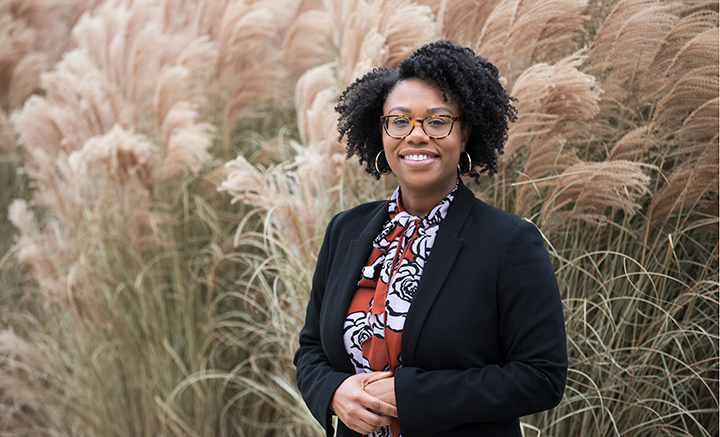Diversity postdoctoral fellow explores Black youth across history

In investigating and documenting young African American lives, Miya Carey must think outside the box when it comes to finding research for her writings.
“When you’re writing about Black youth, a lot of times their stories are not in the archives,” she said. “When you’re doing that archival work, there’s a lot of reading in between the lines.
“I look at newspapers to try to locate girls’ voices; I do interviews. When you’re doing histories of marginalized groups, you have to get creative in how you find sources because those stories aren’t present all the time,” Carey added.
Carey is a Presidential Diversity Postdoctoral Fellow at Binghamton University. The fellowship provides a process to increase the diversity of the University’s faculty by hiring outstanding scholars from different fields, both reflecting the University’s student body and increasing research in disciplines generally lacking diverse faculty. In 2021, when her fellowship ends, Carey will join the History Department in Binghamton’s Harpur College of Arts and Sciences.
Her research examines 20th-century African American women and gender histories, rather than the negative focuses that have often been central to this type of scholarship in the past.
“My current book project looks at Black girlhood in Washington, D.C. I’m interested in Black girls coming to age from roughly the 1930s to the 1960s in the nation’s capital,” Carey said.
“Typically, when we read histories of Black girls coming of age, they’re centered around trauma, racial violence, sexual violence. But I’m really interested in looking at Black girls’ lives and how they created spaces to have more normative childhoods in spite of trauma.”
She specifically focuses on several women’s and youth organizations that were significant to the youth culture of the time period, including the Girl Scouts, the Phyllis Wheatley Young Women’s Christian Association and debutante balls — a formal event that welcomed some young African American girls into Black society.
Carey attended Drew University for her bachelor’s degree in history. It was there she first explored the topic of debutante balls for her dissertation. She became interested in them out of curiosity, but quickly realized their value as symbols of culture and historical significance.
“It reveals a lot about not just how class functions in African American communities, but also that it’s more complex than just some elite ritual,” Carey said. “It’s also, in some ways, kind of subversive, because they’re saying our young women are beautiful and graceful, which contrasted greatly with what mainstream [white] American culture was saying at that time.”
Carey continued her studies as a graduate student at Rutgers University, combining her various interests into a cohesive whole and working with scholars interested in the same topics she was studying.
She also began working on a public-history exploration called The Scarlet and Black Project, which traces the history of students of color and the impact slavery and the slave trade — from the colonial period to the present — had on Rutgers University’s founding and operation. The research she helped conduct included three phases, two of which she worked on as a graduate student and one as a postdoctoral associate.
“[The first volume] looked at the university’s founding through the Civil War,” Carey said. “A lot of that was focused on slavery and enslaved people who were hired out by the university to literally lay the foundation. Phase two of the research looked at the period immediately following the Civil War through World War II. I looked at Jim Crow and segregation and how that impacted the university, the first Black people to attend, their experiences and how the university either accommodated or didn’t accommodate them.”
The first and second parts of the collection were published in 2016 and 2020, respectively. The third, which focuses on student activism and organizing on college campuses after World War II to the present, is being edited.
Through her research, Carey hopes to inspire other, show a greater audience the importance of these stories and create a history of diverse perspectives that can be used to advance future writing.
“What we do impacts the larger public,” she said. “I think, typically, when people think of historians, they just think of us in our own little corners, writing to a very small group of people. But increasingly, you’re seeing scholars say, ‘How can we get this to the larger public?’
“My biggest takeaway is the importance of public history and making this research available to people who aren’t in the academy, who may not even be in our classes, who also deserve to have that information and that knowledge.”
